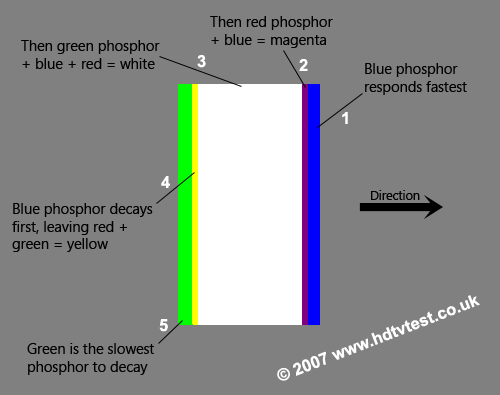When talking about plasma TV, the 2 top concerns for potential buyers are plasma screen burn and excessive glass reflection. While the former can be prevented through judicious use and the latter via ambient light control, there is one other little-known flaw that is inherent in the plasma display technology – phosphor trails. Have a look at this video of a Panasonic TH42PH9 commercial plasma panel (click Play button to start… IE users may need to enable Active X):
Pay close attention to the white bars. As they move faster and faster across the screen, you’ll notice that there are green/ yellow trails behind the white bars, and – to a lesser extent – blue/ purple fringing at the front. These are phosphor trails, also known as “phosphor lag“, “comet trails“, “green tinge“, “yellow smear” or “plainbow” on the forums.
Different chemical elements are used in the production of individual red, green and blue phosphor coating in plasma cells. The difference in chemical properties results in a variation in the excitation and decay time: blue is the fastest; green, the slowest; and red in between. Consider the following illustration of a moving white bar which requires equal mixing of red, green, blue (RGB):

Which explains the blue and magenta fringing at the front of the moving bar, and the yellowish green trail. Because the human eye is least sensitive to blue intensity, people usually only notice the green/ yellow trails when a bright image moves quickly across a dark background. The faster the movement, or the higher the contrast is, the more apparent the phosphor trails become.
The good news is that 99% of plasma TV owners do not see the problem 99% of the time. However, some people who are “cursed” with sensitive eyes (these people usually notice flicker even when the refresh rate on their computer monitor is set at 75Hz) can’t help but notice the phosphor trails. The aim of this article is to make you – if you’re considering buying a plasma TV – aware that such a problem exists, and that you should make sure you’re not susceptible to it before committing yourself.
Despite this shortcoming, plasma flat panel remains one of the most affordable display devices available on the market capable of deep blacks and realistic colour reproduction… and you may not even be susceptible to phosphor trails. Just bring a copy of “Sin City” (a predominantly black-and-white film with fast pans that is notorious for bringing out the worst of phosphor trails) to demo on one of your friend’s plasma TV with the lights down… if you don’t see trails then you should be fine.
As difference in phosphor excitation and decay intervals is inherent in the plasma display technology, if you’re one of the unlucky ones who see phosphor trails, you can only try to alleviate the problem by: